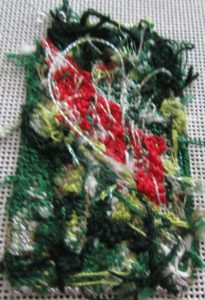
Often we encounter needlepoint where all the areas of color are small and are scattered. This Rogue Needlepoint canvas is almost a poster child for this. The only areas that are a continuous single color are the words. While most of the colors are used in many places, none of the areas are large.
This presents many challenges. First, if you want some variety in texture you need to find different threads. To add texture I limited metallics on the can itself to only the logo. Second your choices for stitches are limited. Initially I tried some Tent variations for the multi-colored can but I found that even the simplest were defeated by the complex color changes. I just could not keep them straight. I ended up using Four-way Continental for the lettering and Skip Tent for the logo background. Otherwise the can is Tent.
Note: I don’t count the top and bottom in this because they show the construction of the can and would have been stitched this way in any case.
Having settled on Tent and the threads I would use I then needed to decide how to stitch it.
I could stitch it row by row or column by column, parking threads and changing colors as I went along. Instead I stitched color by color, mostly in Continental so I would not need to worry about the ridges that happen when adjacent rows of Basketweave are stitched in the same direction.

I stitched from the lightest color to the darkest. The result, seen from the back, is pictured above.
What do we discover from this (besides my messy backs)? You do not see traveling threads except between the darkest colors. That’s because when you stitch this way threads only cross already stitched areas if they are darker than what is between.
This principle is very important to a good result on the front of the canvas. If a darker thread passes behind the unstitched canvas when you stitch that lighter area the stitching will bind that darker thread closer to the canvas. There will only be one layer of thread in front of it (the new stitches’ front) and you will likely see a shadow of that darker thread on the canvas.
If you stitch from light to dark, however, the thread only passes unstitched areas that will be stitched with a darker thread. This makes the tighter binding irrelevant and the shadows won’t show.
What about those dark traveling threads? Because the areas are already stitched, the darker thread now passes over two layers of thread not one, making the stitching thick. In addition there is no binding because the stitching is already done!
No shadows are seen and the scattered areas are successfully stitched.
About Janet M Perry
Janet Perry is the Internet's leading authority on needlepoint. She designs, teaches and writes, getting raves from her fans for her innovative techniques, extensive knowledge and generous teaching style. A leading writer of stitch guides, she blogs here and lives on an island in the northeast corner of the SF Bay with her family

Leave a Reply